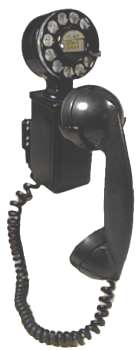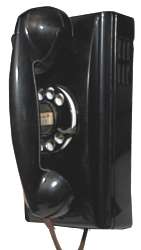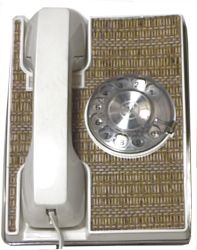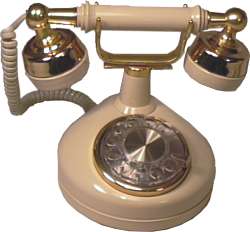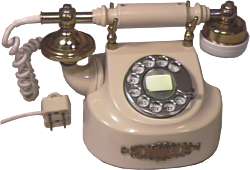Back
to the Cavalcade of Phones
Introduction
Automatic Electric | Western Electric | Other US | International | Intercoms
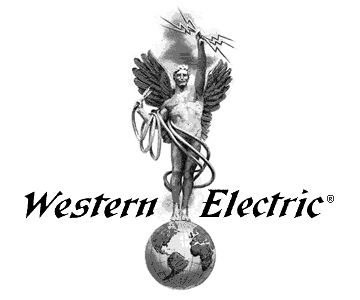
Western Electric Phones
Well, I was going to write this big history and chronology of Western Electric, and it's long term association with the Bell Company, but I don't feel like doing the research, Anyway, there's a good history of WE at David Massey's excellent Tribute to the Telephone site. If you need help with wiring your old WE phone, try Dave Massey's site, or wander over to Mike Elmore's Old Telephone Schematics web site. I'm pulling most of the facts listed here from Richard Mountjoy's book "100 years of Bell Telephones ".
Here are some Western Electric Telephones from my collection, and history off the top of my head. (Feel free to correct me.)
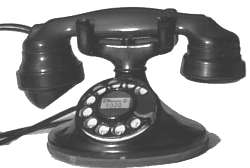 First up is my oldest complete
WE phone. It's a model 202. The 202 is distinguished
from the 102 by it's oval base (the 102 is round). It was produced from
the early 1920s into the early '40s. This particular piece has a microphone
element that is dated 1945, but the handset is of the earlier "E"
type. The 202 is the first WE handset phone designed as such from the
ground up. (The 102 is a redesign using components from the candlestick
phones) This phone is cast metal, and houses only the dial, and a bunch
of switches. There's a separate wall box (in this case metal) which holds
the ringer and the induction coil.
First up is my oldest complete
WE phone. It's a model 202. The 202 is distinguished
from the 102 by it's oval base (the 102 is round). It was produced from
the early 1920s into the early '40s. This particular piece has a microphone
element that is dated 1945, but the handset is of the earlier "E"
type. The 202 is the first WE handset phone designed as such from the
ground up. (The 102 is a redesign using components from the candlestick
phones) This phone is cast metal, and houses only the dial, and a bunch
of switches. There's a separate wall box (in this case metal) which holds
the ringer and the induction coil.
This is a 211 set, the second generation of what's commonly called the "Space Saver". This particular item is dated 1942, and sports an F type handset. The spacesaver originated in the late 20's as the 101 set. The earlier version had a different type "C" dial mounting with a cool-o tubular S shaped neck and the E type handset. I've seen pictures of a similar phone fitted with a touch-tone keypad as well. (I'd about kill for one of those).
The
302 set, introduced in 1936 is the first Western Electric desktop
phone that housed all of the apparatus in a single desktop unit. 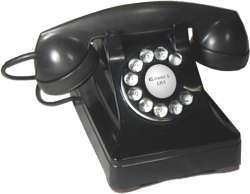 The design of this phone (as well as all Bell phones for the next 25 years)
was the work of Henry Dreyfuss.
(I could go on and on about all the cool stuff that he designed, but just
follow the link). For the first couple of years the bodies of these phones
were cast from metal and painted. After 1941 thermoplastic technology
had evolved to the point where durable housings could be made. Since then
all WE phones have had plastic housings. These phones were produced in
a wide range of colors, but vast majority were black, so the colored sets
are rare. Also the colored plastic seems to be less durable than the black,
so often the colored sets have cracks.
The design of this phone (as well as all Bell phones for the next 25 years)
was the work of Henry Dreyfuss.
(I could go on and on about all the cool stuff that he designed, but just
follow the link). For the first couple of years the bodies of these phones
were cast from metal and painted. After 1941 thermoplastic technology
had evolved to the point where durable housings could be made. Since then
all WE phones have had plastic housings. These phones were produced in
a wide range of colors, but vast majority were black, so the colored sets
are rare. Also the colored plastic seems to be less durable than the black,
so often the colored sets have cracks.
This 352 Wall Set (another Dreyfuss effort) is a nice example of the first plastic WE wall phone. It sports the same type of dial as the earlier WE phones (numbers on the inside of the dial) This phone and it's sister the model 302 share the "F" type handset, a design from before the time when people braced the phone against their ear with their shoulder.
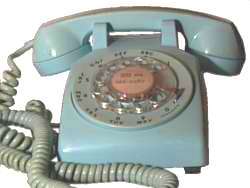 This
is the venerable 500 set. The most popular phone ever
produced on planet earth. They were first made (black only to start) in
1949, and were in continuous production with little change until 1984.
This is still my favorite phone, and I believe that it is the best designed
mass produced object of the 20th century (Can you say Henry
Dreyfuss Associates? I knew you could.). 500 sets manufactured in
the '50s still work fine. I've bought a bunch of these at flea markets,
and yard sales, and the seller always says "it works". I always reply
"They always work" and in fact, (while I'll admit that I don't test them
all any more) short of being physically smashed, the worst problem I've
come across is a sticky dial.
This
is the venerable 500 set. The most popular phone ever
produced on planet earth. They were first made (black only to start) in
1949, and were in continuous production with little change until 1984.
This is still my favorite phone, and I believe that it is the best designed
mass produced object of the 20th century (Can you say Henry
Dreyfuss Associates? I knew you could.). 500 sets manufactured in
the '50s still work fine. I've bought a bunch of these at flea markets,
and yard sales, and the seller always says "it works". I always reply
"They always work" and in fact, (while I'll admit that I don't test them
all any more) short of being physically smashed, the worst problem I've
come across is a sticky dial. 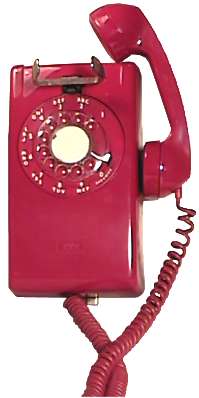
The Companion of the 500 Desk set is the 554 Wall set. All of the internal components and the handset are the same, only the shape and orientation of the housing are changed for vertical operation. This particular piece is actually stamped with the ITT marker, but is part for part compatible with the WE version. In the Late '60s Western Electric licensed it's designs for use by other manufacturers. I've come across phones from Stromberg Carlson, Kellogg and ITT all of which look almost exactly like their WE siblings.
The
Princess phone, in production from 1959 through 1983
was the first WE phone where styling was the 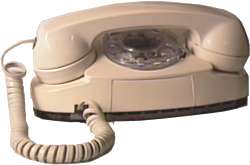 primary feature. In earlier designs the shape of the phone was determined
by the technology of the day, and the physiology of the user. The Princess
phone is designed to look good sitting on the bed stand. The slogan was
"It's little, it's lovely, It lights". The Princess had a dial which lit
up when the receiver was lifted (with current supplied by an external
transformer). This allowed customers to make calls in the dark, and a
switch on the front to put it in "nightlight" mode which kept
the dial lit all the time.
primary feature. In earlier designs the shape of the phone was determined
by the technology of the day, and the physiology of the user. The Princess
phone is designed to look good sitting on the bed stand. The slogan was
"It's little, it's lovely, It lights". The Princess had a dial which lit
up when the receiver was lifted (with current supplied by an external
transformer). This allowed customers to make calls in the dark, and a
switch on the front to put it in "nightlight" mode which kept
the dial lit all the time.
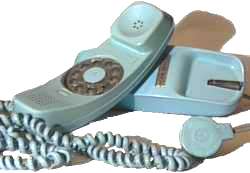 The Trimline
phone, the last of the "pure" Bell phones was the answer to
the customer's desire to lie in bed in the dark (smoking a cigarette),
and make a call without having to get up on one elbow and turn on the
light. There were major technical hurdles that had to be overcome before
this little item with it's lighted dial in the handset could be produced,
and the last of these (shrinking the dial to fit in the handset) wasn't
overcome until 1960. The trimline also introduced the concept of modular
plugs, and changed forever the way people treated their phones.
The Trimline
phone, the last of the "pure" Bell phones was the answer to
the customer's desire to lie in bed in the dark (smoking a cigarette),
and make a call without having to get up on one elbow and turn on the
light. There were major technical hurdles that had to be overcome before
this little item with it's lighted dial in the handset could be produced,
and the last of these (shrinking the dial to fit in the handset) wasn't
overcome until 1960. The trimline also introduced the concept of modular
plugs, and changed forever the way people treated their phones.
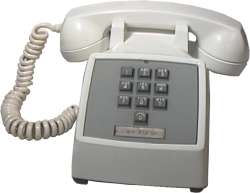 For
decades Ma Bell had been champing at the bit to replace the expensive,
bulky, and difficult to maintain pulse switching equipment with a cheaper
more efficient alternative. By the mid sixties solid state technology
(discovered and developed at Bell Labs) had evolved to the point where
the touch-tone system could be deployed. This is a 1500 set
(count the buttons baby!) dated 1966. I never cared for touch-tone phones
(too square) but sometimes you have to make exceptions.
For
decades Ma Bell had been champing at the bit to replace the expensive,
bulky, and difficult to maintain pulse switching equipment with a cheaper
more efficient alternative. By the mid sixties solid state technology
(discovered and developed at Bell Labs) had evolved to the point where
the touch-tone system could be deployed. This is a 1500 set
(count the buttons baby!) dated 1966. I never cared for touch-tone phones
(too square) but sometimes you have to make exceptions.
The Exeter - what
can I say. It's a rectangle. The handset is squared off - You would think
that it's less comfortable than it's more rounded predecessors, but it's
not. This phone could be placed on a desk, or mounted on a wall, and I've
seen them with several facade materials. This one is the stock grass mat
material (very seventies), but I've seen leather, fabric, even chrome
and vinyl.
In the late seventies
Ma Bell was loosing her hold on the domestic hardware market. People were
clamoring for for more personal and stylish instruments. The result was
the "Design Line", a tedious arrangement whereby the subscriber
purchased the housing, but the phone company leased them the guts. This
example is a model 940 Celebrity.
I'm not really sure
where to place this hideous contribution. It seems to predate the Design
Line, and the bottom is stamped "United States Telephone Company"
. . . "Made in Japan" also "This housing conforms to drawing(Blah
blah blah)" . . . "New York Telephone Company". The guts
are all Western Electric, and are all dated 1970.
Introduction
Automatic Electric | Western Electric | Other US | International | Intercoms

Tell me about all the factual errors in this page,
or ask me to put up a particular phone.
